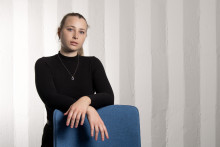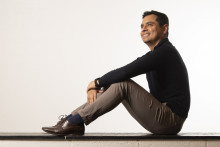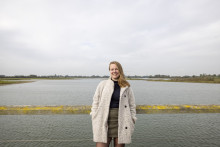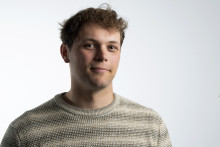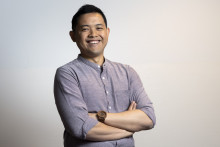Violetta Sharoglazova’s research could be described as ‘counterintuitive’, and perhaps a bit tricky. Not because it is mainly fundamental, but because her field of study – quantum physics – isn’t ruled by the laws of physics we are accustomed to.
‘We all know the logic that governs our usual world, the macro world we live in, but quantum mechanics don’t follow the same rules’, says the PhD candidate. ‘On this scale, things don’t work the way you would expect them to.’ Which, as she says, makes her work fascinating. ‘I didn’t necessarily know that I would end up working on quantum physics, but I think it’s a really good match for me. It forces you to constantly reconsider a lot of your prior understanding. It’s also quite a young field and connects to many emerging technologies.’
'Current conventional computers need years or even decades to solve some optimisation problems. Our system should potentially take a fraction of a second'
Computational device
Sharoglazova’s PhD research is part of a large ERC-funded project focused on building an analog computational device based on optics. Together with her colleagues at the Adaptive Quantum Optics Group, she works towards a device that could significantly speed up solving certain problems.
‘Current conventional computers need years or even decades to solve some optimisation problems. Our system should potentially take a fraction of a second’, explains Sharoglazova. ‘This could be useful for many real-life applications, such as logistics, time scheduling and computer chip design.’
Violetta Sharoglazova
- PhD research topic: Non-Classical Motion and Chaotic Dynamics in Open Quantum Systems
- Work: PhD candidate at the Adaptive Quantum Optics Group, Faculty of Science and Technology
- Education: Master’s degree in Photonics and Quantum Materials at Skolkovo Institute of Science and Technology (Moscow, Russia)
- Originally from: Russia
Quantum tunneling
Her doctoral research, however, is not solely focused on this new device. ‘While I work with the same optical setup as my colleagues, my project focuses more on the basics of quantum physics’, she says. More specifically, she is measuring the speed of tunneling photons.
‘Tunneling is considered to be one of the basic phenomena of quantum physics’, says the UT researcher. ‘As physicists, we learn about it in introductory quantum mechanics courses during bachelor studies, and so people often think we know everything there is to know.’ But there are still open questions surrounding it, stresses Sharoglazova. ‘We have known about the phenomenon for about one hundred years, but it is still not well understood.’
This isn’t for a lack of trying, she adds. ‘People have been investigating the question of tunneling time – both theoretically and experimentally -, but they often get very different results. Which means there is no common and accepted conclusion - yet.’

Reversed rules
Because quantum tunneling doesn’t follow the rules you might expect. ‘In our macro world, we need sufficient energy to surmount a physical barrier. For example, a car needs to be going at a fast enough speed in order to go over a hill’, explains Sharoglazova. ‘In quantum physics, however, particles can sometimes tunnel through a barrier even if they don’t have enough energy.’
The doctoral candidate is therefore trying to figure out what speed the particles acquire while passing the barrier. ‘In my setup, I change the initial energy of the photons and measure their speed after they hit the potential barrier’, she explains. ‘In a macro world, the more energy you have, the less time you need to surmount a barrier. For quantum tunneling, it seems to be reversed.’
The PhD researcher enjoys that she can directly test these ‘paradoxical’ rules. ‘Our platform allows us to do many different experiments. In addition, we have a device that allows us to create arbitrary potential landscapes very fast and test them in our platform. This is amazing. It’s like a playground where we can test many different ideas. Usually in physics, you just have to imagine how things work or you can do some simulations. Being able to see it with your own eyes in real time, that is very beautiful and exciting.’
'As it always is with fundamental research, you never know where your work can lead to'
Fundamental and applied
Violetta Sharoglazova’s research revolves around very fundamental physics and partly aims to contribute to the interpretation of quantum mechanics. However, quantum tunneling is already used in real-life applications, such as scanning tunneling microscopy, semiconductor devices and quantum computing, and it could potentially lead to more new technologies.
‘You can use the phenomenon without having a fundamental understanding of some of its aspects’, says Sharoglazova. ‘Yet, as it always is with fundamental research, you never know where your work can lead to and how it could be applied one day.’
Applying her research in real life is something Sharoglazova is also aiming for. ‘Quantum tunneling is only one part of my PhD research. I want to improve our fundamental understanding of physics, but I also want to work on applied research’, she says. ‘I am curious about how our world is set up, and I want to contribute to new computational devices that help solve our problems faster.’



